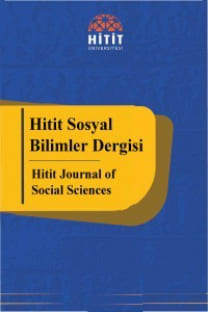KAOS TEORİSİ’NİN GENEL BİR DEĞERLENDİRMESİ
Kaos Teorisi, ünlü Avusturya asıllı bilim adamı Ludvig von Bertalnffy’nin Genel Sistem Teorisi’nden türetilmiş çağdaş bir yaklaşımdır. Bertalanffy’nin sistemi karşılıklı bir etkileşim içinde olan ortak özellikli ve kompleks yapıdaki parçalar olarak tanımlamıştır. Sistem, öngörülebilir yani doğrusal, deterministik ya da öngörülemez yani doğrusal olmayan, probabilistiktir. Bu nedenle, sistem iç ve dış çevresinin etkisi ile yeni denge noktaları bularak değişim sürdürür. Kaos Teorisi ise, istikrarsız, periyodik ve doğrusal olmayan sistemlerin dinamik hareketleri ile ilgilenir. Kaotik yapılar, özelliği gereği, başlangıç durumundan bağımsız olarak, küçük bir etki sonucunda, denge noktasından hareket ederek, yeni bir çekim merkezinde ve kritik noktada denge sağlarlar. Ancak, kaotik sistemler, dengelerini uzun vadede korumak yerine, en küçük bir etki ile harekete geçip, farklı hareket kalıpları içinde yeni dengeler bulurlar. Dolayısı ile, değişim süreci öngörülemeyen yapıların yeni dengelerinin hesap edilmesine katkısı nedeni ile, Kaos Teorisi psikoloji, fizik, işletme, yönetim, biyoloji, ekonomi ve stratejik yönetim gibi bilim alanlarında uygula şansı bulur. Bu çalışmanın amacı, Kaos Teorisi’ni, özgün bir bakış açısı ile değerlendirmek, kapsamı Genel Sistem Teorisi’nden başlayarak günümüzdeki uygulama alanları hakkında bilgi vermek ve de bu teorik temelli çalışmayı kapsamlı ve güvenilir veri tabanlarından sağlanan kaynaklar ile zenginleştirerek literatüre katkıda bulunmaktır.
Anahtar Kelimeler:
Kaos teorisi, Doğrusal olmayan sistemler, Doğrusal Sistemler, Değişim
___
- ARCISZEWSKI, T.; SAER, T. ve SCHUM, D. (2003), “Conceptual designing: Chaos—based approach”, Journal ofIntelligent and Fuzzy Systems, Vol. 13, pp. 45 — 60.
- BERTALANFFY, von L. (1972), “The History and Status of General Systems Theory”, Academy qf Managementjoumal, Vol. 15, No. 4, pp. 407—426.
- DIAMOND, A. (1993), “Chaos Science: Ubiquitous revolutionary theory has implications for marketing researchers and their predictions”, Marketing Research, Vol. 5, No. 4, pp. 9—14.
- DOLAN, S.; GARCIA, S. ve AEURBACH, A. (2003); “Understanding and Managing Chaos in Organizations”, International ]oumal thanagement, Vol. 20, No. 1, pp. 23—35.
- GULYAEV, S. ve STONYER, H. (2002), “Making a map of science: general systems theory as a conceptual framework for tertiary science education”; International] oumal of Science Education, Vol. 24, No. 7, pp. 753—769.
- HELOU, M. ve CADDY, I. (2006), “Definition Problems and a General Sistems Theory Perspective in Supply Chain Management”; Problems and Perspectives in Management, Vol. 4, N o. 4, pp. 77—83.
- HOLDEN, L. (2005), “Complex adaptive systems: concept analysis”, ]oumal thdvanced Nursing, Vol. 52, No. 6, pp. 651—657.
- HORTON, T. (2006), “Competition or monopoly? The implications of complexity science, chaos theory and evolutionary biology for antitrust and competition policy”, TheAntitmstBulletin, Vol.51, No. 1, pp. 195—214.
- HUDSON, C. (2000), “At The Edge of Chaos: A New Paradigm for Social Work”, journal of Social Work Education, Vol. 36, No. 2, pp. 215—230.
- KWIATKOWSKA, T. (2001), “Beyond Uncertanities”, Ethics & the Environment, Vol. 6, No.1, pp. 96—115.
- LOCKER, M. (2006); “Systems Theory and the Conundrum of Ens: Thoughts and Aphorisms”, Foundations (f Science, Vol. 11, pp. 297—317.
- MCBRIDE, N. (2005), “Chaos theory as a model for interpreting information systems in organizations”, Iry‘ormation Systems journal, Vol.15, pp. 233—254.
- PASCALE, R. (1999), “SurŞng the Edge of Chaos”, Sloan Management Review, pp. 83—94.
- PRYOR, R. ve BRIGHT, J. (2006), “Counseling chaos: techniques for practitioners”; Journal of Employment Counseling, Vol. 43, pp. 2—16.
- SMITH, W ve HIGGINS, M. (2003); “Postmodernism and Popularisation: The Culture Life of Chaos Theory”, Culture and Organization, Vol. 9, No. 2, pp. 93—104.
- SPRONCK, W ve COMPERNOLLE, T. (1997); “Sytems Theory and Family Therapy: From a Critique on Systems Theory to a Theory on Sytem Change”, Contemporary Family Thearaphy, Vol. 19, No.2, pp. 147—175.
- STAVERN, van 1. (1999); “Chaos Theory and Institutional Economics: Metaphor Model?”, Journal (f EconomicIssues, Vol. 23, N o. 1, pp.141—160.
- WARREN, K.; FRANIQIN, C. ve STREETER, C. (1998), “N ew Directions in Systems Theory: Chaos
- and Complexity”, Social Work, Vol. 43, N 0.4, pp. 357—372.
- Yayın Aralığı: Yılda 2 Sayı
- Başlangıç: 2008
- Yayıncı: Hitit Üniversitesi
Sayıdaki Diğer Makaleler
DAVID RICARDO İLE JOSEPH ALOIS SCHUMPETER’İN TEKNOLOJİK GELİŞME KURAMLARININ KARŞILAŞTIRILMASI
TÜRK EDEBİYATI DERSLERİNDE ELEŞTİREL DÜŞÜNME EĞİTİMİ
Mehmet KURUDAYIOĞLU, Gamze ÇELİK
KIYASLAMA (BENCHMARKING) YÖNTEMİ VE OTEL İŞLETMELERİNDE KULLANIMINA İLİŞKİN TEORİK BİR ÇALIŞMA
KAOS TEORİSİ’NİN GENEL BİR DEĞERLENDİRMESİ
YENİ KAMU YÖNETİMİ ANLAYIŞI: WEBER BÜROKRASİSİNİN SONU MU?
TÜRKİYE’DE DOĞRUDAN YABANCI YATIRIMLAR (DYY) VE YURTİÇİ YATIRIMLAR ARASINDAKİ NEDENSELLİK İLİŞKİSİ
